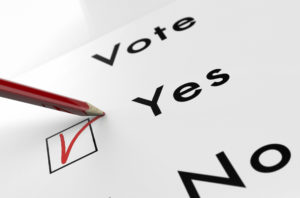
After serving as Evelyn Murphy’s campaign manager and helping elect her as the first woman to ever win statewide in Massachusetts history, I decided to keep my hand in elections by running statewide ballot issue campaigns instead of candidate campaigns.
Statewide ballot issue campaigns — like candidate campaigns, often broke new ground in the use of technology and other communications tools. I was interested in staying ahead of the technology learning curve, and ballot campaigns became my laboratory for employing new and emerging technology.
The ballot business has been a wild and successful ride for me over the last 20 plus years. This is advocacy in its most pure form— unrelenting pressure combined with the unpredictability of election night.
The other challenges involve the position in the polls when you begin the race, not unlike candidate races. And as in candidate races, having enough money to be competitive in ballot races is the other factor determining whether you have a chance to win. It’s always best to have the most money, but I have found that even being outspent by the other side, I was able to win as long as I had a competitive budget.
My successful “YES” record includes a “YES” to keep the seat belt law in by almost 20 points in 1994, a “YES” to reduce the state’s investment income tax rate in 1998 by a 83-17% margin, a “YES” to create a state income deduction for charitable deductions in 2000 by a 72-28% margin, and “YES” to repeal the new state sales tax on alcohol in 2010 by a 52-48% margin.
Each of those “YES” campaigns had its challenges, but the repeal of the alcohol tax in 2010 was most difficult, due to another question on the ballot that same year to reduce the entire sales tax, not just the sales tax on alcohol. Nonetheless, we won by 4 points in the face of an overwhelming victory by Governor Deval Patrick, whose supporters were very much in favor of keeping the tax on alcohol.
My “NO” campaigns all dealt with different topics and had different challenges, but all were winners. There was the “NO” in 1990 on outlawing the use of private consultants (private engineers) on state road, water, and sewer projects. This ballot question, initiated by a state union, resulted in an almost 20-point victory for my clients. Working together with another firm, there was also the “NO” campaign on a controversial health care question in 2000, a tough win by 4 points. This was the first time in Massachusetts that access to health care and health care costs became significant statewide issues.
Then there was the ballot question in 2006 on selling wine in grocery stores, a business brawl between the state’s largest supermarkets and the wine and beer industry. On election day in November of 2006, “NO” on wine in supermarkets won by 12 points after being behind by 35 points in March. In that campaign, the supermarket industry outspent the beer and wine distributors by over $2 million.
In 2012, I signed on to run the “NO” on physician-assisted suicide, which some called “the Right to Die” ballot question. This was unlike any other ballot question I had faced. It wasn’t about taxes, seat belts, or alcohol. This was about the threshold question on end of life and whether some people should be permitted to end their life by ingesting 100 pills of Seconal. This question had moral, religious, and medical beliefs all intertwined.
In 2012, Massachusetts was a state where voter sentiment on allowing a person to choose to end his or her life was overwhelmingly favored by voters. After starting our campaign down 65-30% in March of 2012, we won a two-point victory in November of 2012, despite the fact that Massachusetts is a state where the voters are 40% religious and 60% secular.
The key strategic finding for the win was the discovery that voters favored the concept of physician-assisted suicide but disapproved of the ballot language and provisions on how a person would end their life. We hammered that controversial ballot language in our advertising, making this an upset national win.
These ballot questions are high-risk, complicated, and pressure-filled endeavors, utilizing survey research, message development, paid advertising, direct mail, digital technology, and advertising, media buying, and election-day operations.